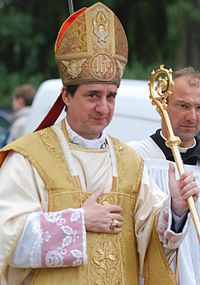Alfonso de Galarreta
His Excellency, the Most Reverend Alfonso de Galarreta The International Seminary of Saint Pius X | |
|---|---|
| Motto | Omnia per Mariam (All by Mary) |
| Coat of arms |  |
Ordination history of Alfonso de Galarreta | |||||||
|---|---|---|---|---|---|---|---|
| |||||||
| |||||||
Alfonso de Galarreta Genua,
Born in
The SSPX denied the legal validity of the excommunication, saying that the consecrations were necessary due to a moral and theological crisis in the Catholic Church and thus continued to operate regardless.[4][5][6] After the consecrations, Bishop de Galarreta became the Rector of the Our Lady Co-Redemptrix Seminary at La Reja in Argentina, which serves Latin America. He became the Superior of the SSPX District of Spain and Portugal in 1994, before becoming the Second Assistant of the Society of Saint Pius X in 2002. During the pontificate of Pope Benedict XVI in 2009, the Holy See officially declared the remission of the SSPX's contested automatic excommunications.[7]
Écône consecrations
In June 1988
On June 30, 1988 de Galarreta and the three other priests were consecrated bishop by Archbishop Lefebvre and Bishop
On July 2, 1988,
The SSPX denied the validity of the excommunications, saying that the consecrations were necessary due to a moral and theological crisis in the Catholic Church.[10][5][11]
In 2009, the excommunications were lifted by Pope Benedict XVI.[12]
SSPX Bishop

The canonical situation of the four bishops thus became the same as that of the other clergy of the Society, who are suspended a divinis.[13]
References
- ^ General Assistants
- ^ SSPX's members of theological commission named
- ^ Apostolic letter Ecclesia Dei Archived January 29, 2015, at the Wayback Machine
- ^ SSPX FAQ Question 11 (29 June 1987). SSPX.org. Accessed 2008-01-01 Archived 12 April 2011 at the Wayback Machine
- ^ a b The 1988 consecrations: a theological study (July & September 1999). Sì sì no no via SSPX.org. Accessed 2008-01-01 Archived 2011-08-07 at the Wayback Machine
- ^ The 1988 consecrations: a canonical study (November 1999). Sì sì no no via SSPX.org. Accessed 2008-01-01 Archived 2011-08-07 at the Wayback Machine
- ^ Remissione della scomunica latae sententiae ai vescovi della Fraternità sacerdotale San Pio X, 24.1.2009 Archived 2009-02-01 at the Wayback Machine
- ^ Apostolic letter Ecclesia Dei (July 2, 1988). Vatican.va. Accessed May 18, 2017.
- ^ Interview for 30 days Archived 2006-02-13 at the Wayback Machine (2005). 30giorni. Retrieved May 18, 2017.
- ^ SSPX FAQ Question 11 Archived 2011-04-12 at the Wayback Machine (29 June 1987). SSPX.org. Retrieved May 18, 2017.
- ^ The 1988 consecrations: a canonical study Archived 2011-08-07 at the Wayback Machine (November 1999). Sì sì no no via SSPX.org. Retrieved May 18, 2017.
- ^ "Decree remitting the excommunication "latae sententiae" of the Bishops of the Society of St Pius X".
- ^ Letter of the Pontifical Commission Ecclesia Dei of 29 September 1995

